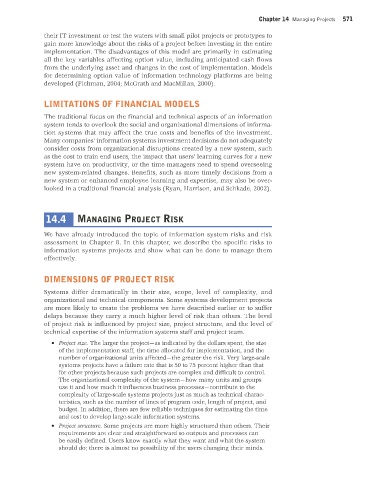Page 572 -
P. 572
Chapter 14 Managing Projects 571
their IT investment or test the waters with small pilot projects or prototypes to
gain more knowledge about the risks of a project before investing in the entire
implementation. The disadvantages of this model are primarily in estimating
all the key variables affecting option value, including anticipated cash flows
from the underlying asset and changes in the cost of implementation. Models
for determining option value of information technology platforms are being
developed (Fichman, 2004; McGrath and MacMillan, 2000).
LIMITATIONS OF FINANCIAL MODELS
The traditional focus on the financial and technical aspects of an information
system tends to overlook the social and organizational dimensions of informa-
tion systems that may affect the true costs and benefits of the investment.
Many companies’ information systems investment decisions do not adequately
consider costs from organizational disruptions created by a new system, such
as the cost to train end users, the impact that users’ learning curves for a new
system have on productivity, or the time managers need to spend overseeing
new system-related changes. Benefits, such as more timely decisions from a
new system or enhanced employee learning and expertise, may also be over-
looked in a traditional financial analysis (Ryan, Harrison, and Schkade, 2002).
14.4 MANAGING PROJECT RISK
We have already introduced the topic of information system risks and risk
assessment in Chapter 8. In this chapter, we describe the specific risks to
information systems projects and show what can be done to manage them
effectively.
DIMENSIONS OF PROJECT RISK
Systems differ dramatically in their size, scope, level of complexity, and
organizational and technical components. Some systems development projects
are more likely to create the problems we have described earlier or to suffer
delays because they carry a much higher level of risk than others. The level
of project risk is influenced by project size, project structure, and the level of
technical expertise of the information systems staff and project team.
• Project size. The larger the project—as indicated by the dollars spent, the size
of the implementation staff, the time allocated for implementation, and the
number of organizational units affected—the greater the risk. Very large-scale
systems projects have a failure rate that is 50 to 75 percent higher than that
for other projects because such projects are complex and difficult to control.
The organizational complexity of the system—how many units and groups
use it and how much it influences business processes—contribute to the
complexity of large-scale systems projects just as much as technical charac-
teristics, such as the number of lines of program code, length of project, and
budget. In addition, there are few reliable techniques for estimating the time
and cost to develop large-scale information systems.
• Project structure. Some projects are more highly structured than others. Their
requirements are clear and straightforward so outputs and processes can
be easily defined. Users know exactly what they want and what the system
should do; there is almost no possibility of the users changing their minds.
MIS_13_Ch_14_global.indd 571 1/17/2013 2:31:59 PM

